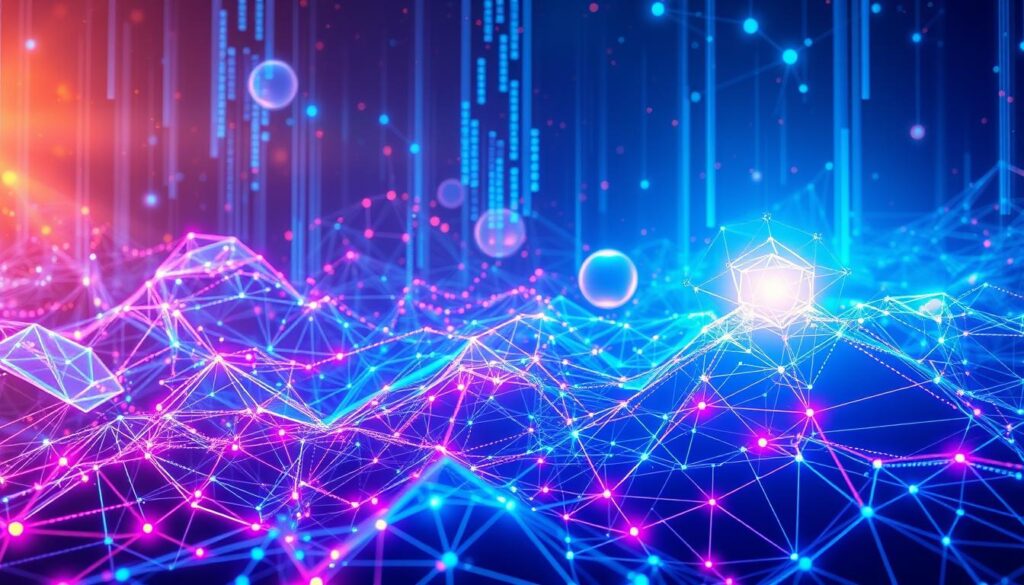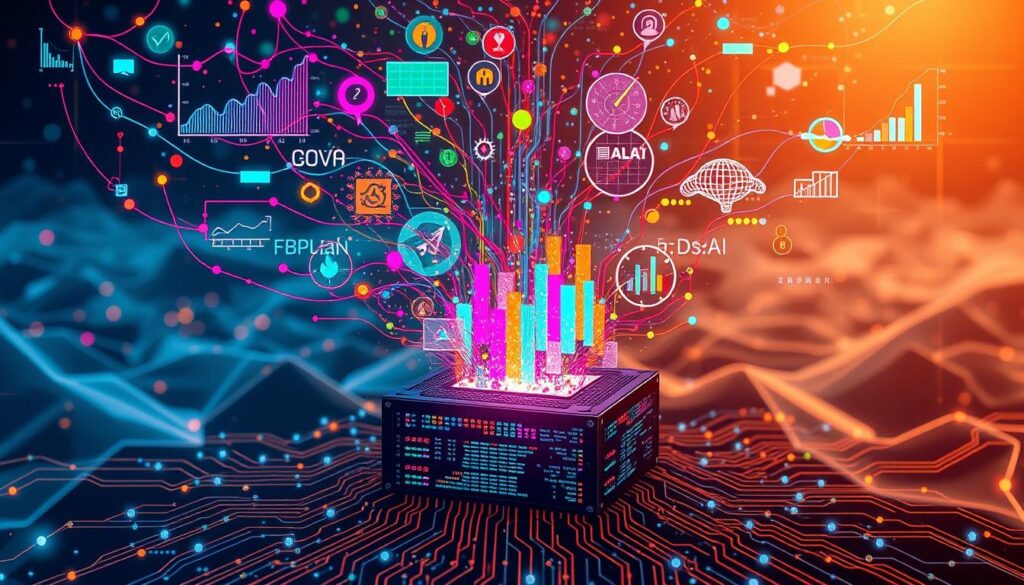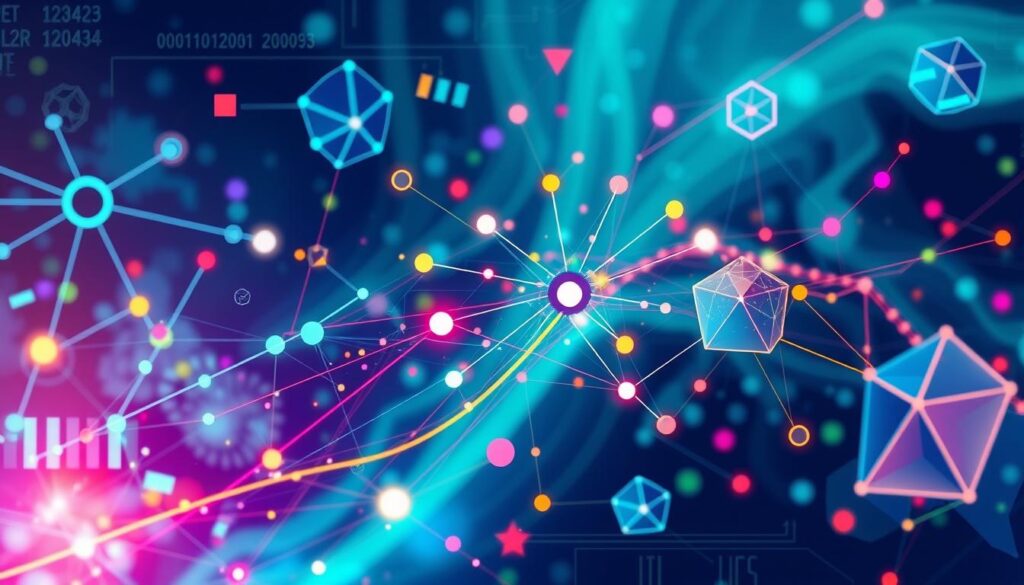Machine learning is changing the world fast. It’s making big impacts in many areas of life. If you love data, tech, or just want to know more, learning about machine learning can be exciting. We’ll cover the basics, its uses, and how it’s changing India.

Key Takeaways
- Discover the core principles of machine learning and how it differs from traditional programming.
- Explore the diverse applications of machine learning in fields like healthcare, finance, and e-commerce.
- Understand the importance of data and its role in the machine learning process.
- Learn about the different machine learning models, including supervised and unsupervised learning.
- Gain insights into the future of machine learning and its potential impact on businesses and individuals in India.
What is Machine Learning?
Machine learning is a field that has changed how we use technology. It’s a part of artificial intelligence that lets computers learn and get better over time. They do this without being told exactly what to do.
This new way of working lets systems do tasks well by using special algorithms. These algorithms are based on data, not just rules.
Defining Machine Learning
Machine learning is about training algorithms to make predictions or decisions from data. This lets computers learn and get better at tasks. The more data they get, the better they become.
They can spot patterns, make accurate forecasts, and automate complex tasks. This is all thanks to the data they learn from.
Applications of Machine Learning
Machine learning is used in many ways. It helps with everything from recommending products online to diagnosing medical conditions. It’s also used in self-driving cars.
This technology uses big datasets and powerful computers. It can find insights and make decisions that are often better than humans.
Some common machine learning applications include:
- Predictive analytics and forecasting
- Image and speech recognition
- Fraud detection and risk management
- Personalized content and recommendation systems
- Autonomous vehicles and robotics
- Natural language processing and text analysis
As machine learning grows, so does its potential. It’s changing many industries and improving lives worldwide. By using data and artificial intelligence, machine learning is shaping the future.
Understanding Machine Learning Algorithms
Machine learning algorithms are key to this new technology. They let computers analyze data, find patterns, and make smart choices. There are two main types: supervised and unsupervised learning. Knowing about these algorithms is key to using this technology well.
Supervised Learning Algorithms
Supervised learning uses labeled data. This means the input and the expected output are known. These algorithms learn from examples and make predictions on new data. Examples include linear regression and decision trees.
Unsupervised Learning Algorithms
Unsupervised learning works with data without labels. It finds hidden patterns and structures. Algorithms like k-means clustering and principal component analysis are used for this.
Each algorithm has its own strengths and weaknesses. They are best for different problems. Knowing which to use is crucial for machine learning success.
“Machine learning is the future, not only for AI, but for all of us.” – Fei-Fei Li, Co-Director of the Stanford University Human-Centered Artificial Intelligence Institute
Learning about machine learning algorithms opens up new ways to make decisions. It can change your business and keep you ahead in tech.
The Importance of Data in Machine Learning
Data is at the core of machine learning. Algorithms need big datasets to learn and predict. The quality and prep of this data are key to success.
Data Preparation and Preprocessing
Before training, data must be prepared and preprocessed. This includes cleaning, formatting, and creating new features. Cleaning fixes missing values and errors. Formatting makes data work with algorithms. Creating new features boosts model performance.
Types of Data Used in Machine Learning
- Structured data: Found in spreadsheets or tables. It’s easy for algorithms to use and often for supervised learning.
- Unstructured data: Includes images, text, audio, or video. It’s harder to work with but deep learning has made it more accessible.
Quality and prep of machine learning data are vital. Investing in data prep helps models give accurate insights.

“Data is the foundation of machine learning. Without high-quality data, even the most sophisticated algorithms will struggle to produce meaningful results.”
Understanding machine learning
Machine learning lets computers learn and get better over time without being told how. It finds patterns in data to make predictions or decisions. The machine learning process includes steps like collecting data, preparing it, choosing a model, training it, and checking how well it works.
To really get how machine learning works, you need to know the basic machine learning concepts. Ideas like overfitting, underfitting, and the bias-variance tradeoff are key. They help make models that work well even with new data.
- Overfitting: A model that’s too complex might not do well with new data. It’s important to avoid this to make sure the model works well in the future.
- Underfitting: This happens when a model is too simple and misses important data patterns. Finding the right balance is crucial for good performance.
- Bias-Variance Tradeoff: This idea shows the need to balance fitting the training data well (low bias) with being able to handle new data (low variance). Getting this balance right is a big challenge in machine learning.
Knowing these machine learning concepts helps you understand the machine learning process better. It also helps you use it to solve complex problems in different areas.
| Concept | Description |
|---|---|
| Overfitting | A model that’s too complex and fits the training data too well, leading to poor performance on new data. |
| Underfitting | A model that’s too simple and misses important data patterns, leading to poor performance on all data. |
| Bias-Variance Tradeoff | The need to balance fitting the training data well (low bias) with handling new data well (low variance). |

“The true sign of intelligence is not knowledge but imagination.” – Albert Einstein
By diving into these basic machine learning concepts and understanding the machine learning process, you can unlock its full power. This lets you solve complex problems in your field effectively.
Machine Learning Models and Training
Exploring machine learning is both exciting and challenging. At its core are the machine learning models. These are mathematical ways to understand data relationships. Training these models is key to their success.
Supervised Learning
Supervised learning models use labeled data. This means the input and desired output are known. They learn to predict new data accurately. Examples include linear regression and decision trees.
Unsupervised Learning
Unsupervised learning models find patterns in data without labels. They look for hidden structures and relationships. K-means clustering and principal component analysis are examples.
Choosing the right machine learning models and training method is important. It depends on the problem and data available. Understanding supervised learning and unsupervised learning helps pick the best approach. This unlocks your data’s full potential.
| Supervised Learning | Unsupervised Learning |
|---|---|
| Trained on labeled data Learns to map inputs to outputs Examples: Linear Regression, Logistic Regression, Decision Trees | Discovers patterns in unlabeled data Identifies hidden structures and relationships Examples: K-Means Clustering, Principal Component Analysis |
“The choice of the right machine learning model and training approach is crucial in unlocking the full potential of your data.”
Conclusion
In this article, you’ve learned about machine learning. You now know what it is, how it’s used, and why data and algorithms are key. You’ve also discovered the different types of machine learning models and how they’re trained.
Machine learning is changing many industries in India. It’s important to keep up with this technology. By understanding machine learning, you can use it to innovate, make better decisions, and find new opportunities.
This article has given you a good start in understanding machine learning. Whether you’re looking to use it personally or in your business, this knowledge will help you grow. It’s a great foundation for exploring and applying this powerful technology.
FAQ
What is machine learning?
Machine learning is a part of artificial intelligence. It lets computers learn and get better over time. They do this without being told exactly what to do.
It uses special algorithms and models. These help systems do tasks well, even without being programmed in detail.
What are the applications of machine learning?
Machine learning is used in many ways. It helps with things like recommending products and diagnosing diseases. It also makes self-driving cars possible.
In India, it’s changing how we live and work. Computers can now understand data, find patterns, and make smart choices.
What are the different types of machine learning algorithms?
There are many types of machine learning algorithms. Some, like supervised learning, use labeled data. Others, like unsupervised learning, find patterns in data without labels.
Knowing about these algorithms is key. It helps us use machine learning in the right way.
Why is data important in machine learning?
Data is crucial for machine learning. Algorithms need lots of data to learn and make good predictions. Getting the data ready is a big step.
It’s important to clean and prepare the data. The type of data also affects which models and algorithms to use.
How does machine learning work?
Machine learning is about training models to find patterns in data. Then, they make predictions or decisions based on that data.
The process starts with collecting data. Then, it’s cleaned and prepped. After that, a model is chosen, trained, and tested.
It’s important to know about issues like overfitting and bias-variance tradeoff. These help us use machine learning well.
What are the different machine learning models and training approaches?
Machine learning models show how data is related. The training process adjusts these models to do a task better.
Some models, like supervised learning, use labeled data. Others, like unsupervised learning, find patterns in data without labels.
The right model and training method depend on the problem and the data available.